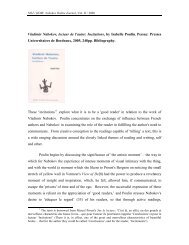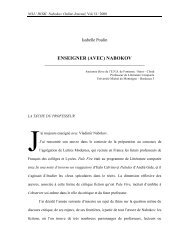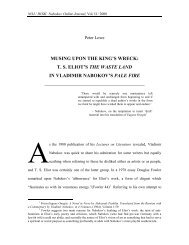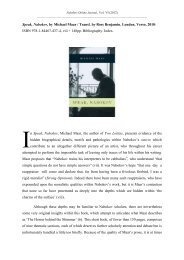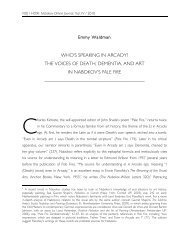THE LOLITA EFFECT: SEXY GIRLS IN THE MEDIA1
THE LOLITA EFFECT: SEXY GIRLS IN THE MEDIA1
THE LOLITA EFFECT: SEXY GIRLS IN THE MEDIA1
- TAGS
- lolita
- sexy
- girls
- etc.dal.ca
Create successful ePaper yourself
Turn your PDF publications into a flip-book with our unique Google optimized e-Paper software.
NOJ / НОЖ: Nabokov Online Journal, Vol. II / 2008<br />
M. Gigi Durham<br />
<strong>THE</strong> <strong>LOLITA</strong> <strong>EFFECT</strong>:<br />
<strong>SEXY</strong> <strong>GIRLS</strong> <strong>IN</strong> <strong>THE</strong> MEDIA 1<br />
________________________________________________<br />
She it was to whom ads were dedicated: the ideal<br />
consumer, the subject and object of every foul<br />
poster.<br />
— Vladimir Nabokov, Lolita<br />
L<br />
ast Halloween, a five-year-old girl showed up at my doorstep decked out in a<br />
tube top, a gauzy miniskirt, platform shoes, and glittering eye shadow. The<br />
outfit projected a rather tawdry adult sexuality. “I’m a Bratz!” the tot piped<br />
up proudly, brandishing a look-alike doll clutched in her chubby fist. I had an instant,<br />
dizzying flashback to an image of a child prostitute I had seen in Cambodia, dressed in a<br />
disturbingly similar outfit.<br />
I was startled and put off—but perhaps I shouldn’t have been. The little girl who<br />
came to my door is part of a widespread cultural shift that has become an American<br />
norm. Increasingly, very young girls are becoming involved in a sphere of fashion,<br />
1 The essay is an introduction to M. Gigi Durham’s upcoming book, The Lolita Effect: The Media<br />
Sexualization of Young Girls and What We Can Do About It (New York: Overlook Press, summer 2008).<br />
Published by permission.
G. Durham. “The Lolita Effect”<br />
images, and activities that encourage them to flirt with a decidedly grown-up eroticism<br />
and sexuality—and the girls playing with these ideas are getting younger and younger<br />
every year.<br />
So why am I perturbed by this trend? I am a pro-sex feminist, by which I mean<br />
that I don’t see sex as taboo or hush-hush; I think sex is a normal and healthy part of life,<br />
even of children’s lives. I want my two young daughters—indeed, all girls—to grow up<br />
unafraid of and knowledgeable about their bodies, confident about finding and expressing<br />
sexual pleasure, able to be both responsible and adventurous in the realm of sex. I want to<br />
talk to my daughters honestly and communicate my perspectives and values about this<br />
complex aspect of human experience (and I want them to be able to have these same<br />
kinds of conversations with their dad, and with other people whose opinions matter to<br />
them). Above all, as they grow into adults, I want them to be able to think ethically about<br />
sex, just as I want them to carefully think through their ethical positions regarding<br />
everything else. These are the themes I try to emphasize when I teach classes in gender<br />
and sexuality, and when I present workshops to elementary- and middle-school children.<br />
For years I’ve fought against the ways in which girls’ sexuality has been denied,<br />
repressed, and moralized about. I despise the social double standards that celebrate boys’
NOJ / НОЖ: Nabokov Online Journal, Vol. II / 2008<br />
“studliness” and condemn girls’ desires. I believe in girls’ power and strength, and in<br />
working to ensure that they have the space and safety to make free choices about their sex<br />
lives.<br />
But the flip side of those proactive ideas is the cold recognition that female<br />
sexuality in our world is often exploitative, abusive, and harmful. Girls and women are<br />
battered, raped, sold, and slain, and these acts are sex crimes, motivated by gender and<br />
sexuality. An estimated two million children, most of them girls, are sexually abused<br />
every year through child prostitution and trafficking. There is such a thing as sexual<br />
harm. And there is a battle being fought against sex and ideas about sex that destroy the<br />
lives of women and girls.<br />
All of these issues come up when I hear about three-year-olds wearing Playboy T-<br />
shirts to school, or grade-schoolers aspiring to be lap dancers. Many cultural critics these<br />
days see these developments as harmless, or even positive. Jennifer Baumgardner,<br />
coauthor of the feminist manual Manifesta, argues that when little girls sing Spice Girls<br />
songs or don stiletto heels, they are tapping into a spirit of “fierce, fun independence.”<br />
It’s easy to recognize how alluring these symbols of playful femininity are, and how they<br />
can be reworked ironically or campily to convey new messages about “girl power.” But is<br />
it realistic to believe that young children would be aware of these subversive and<br />
liberating possibilities? How should we respond to the increasing sexualization of<br />
girlhood, especially when it begins in kindergarten or earlier?<br />
One angry mom calls these kids “prosti-tots,” and another describes them as<br />
“kinderwhores.” Others declare that corporate marketing machines are turning little girls<br />
into “sex bait.” It’s easy to see why. While the exhibitionist antics of Paris Hilton and the
G. Durham. “The Lolita Effect”<br />
Pussycat Dolls mesmerize small girls around the world, retailers like Abercrombie &<br />
Fitch create thong underwear for ten-year-olds adorned with seductive slogans like<br />
“Wink, Wink” and “Eye Candy.” Not to be outdone, the British chain BHS has launched<br />
a line of “Little Miss Naughty” underwear that offers push-up bras and lacy briefs to<br />
preteens. In 2007, toy manufacturer Tesco sold a pink plastic “Peekaboo Pole Dancing”<br />
kit, complete with tiny garter and toy money for stuffing into it, on its “Toys and Games”<br />
Web site, until pressure from parents’ groups forced them to reclassify the product—<br />
though it’s still on the market.<br />
* * *<br />
T<br />
he turn of the new millennium has spawned an intriguing phenomenon: the<br />
sexy little girl. She’s an all-too-familiar figure in today’s media landscape:<br />
the baby-faced nymphet with the preternaturally voluptuous curves, the one<br />
whose scantily clad body gyrates in music videos, poses provocatively on teen magazine<br />
covers, and populates cinema and television screens around the globe. She’s become a<br />
fixture in Western pop culture: we all know her various incarnations, from Britney Spears<br />
to the sex-kittenish cartoon girls of animé, from Brooke Shields’s child prostitute in<br />
Pretty Baby to JonBenét Ramsey’s beauty queen persona and the Australian preteen sex<br />
symbol Maddison Gabriel. She’s been celebrated and censured, and she serves as a<br />
symbolic flashpoint for raging debates about gender, sexuality, the definition of<br />
childhood, and the criteria for social standards of acceptability.
NOJ / НОЖ: Nabokov Online Journal, Vol. II / 2008<br />
Perhaps one reason for our fascination with the sexy little girl is her tricky double<br />
role in contemporary society—she is simultaneously a symbol of female empowerment<br />
and the embodiment of a chauvinistic “beauty myth.” She invokes the specter of<br />
pedophilia while kindling the prospect of potent female sexuality. “If you’ve got it, flaunt<br />
it!” we urge, while at the same time we decry the absurd and capricious standards of<br />
femininity that dismantle women’s lives. “Why the fascination with JonBenét?” we<br />
demand, as we scour the tabloids that blare the latest news of her case, accompanied by<br />
titillating photographs of the blonde six-year-old in showgirl plumes. The sexy girl<br />
fascinates us and repels us; she haunts our imagery and our imaginations, and we know<br />
her best by a nickname that evokes meanings far beyond their literary origin: she is<br />
Lolita.<br />
The term has become an everyday allusion, a shorthand cultural reference to a<br />
prematurely, even inappropriately, sexual little girl—that is, a girl who is by legal<br />
definition not yet an adult and is therefore outlawed from sexual activity. Because of this<br />
legal and cultural taboo, she is also wrong—wicked, even—to deliberately provoke<br />
sexual thoughts. And the “Lolitas” of our time are defined as deliberate sexual<br />
provocateurs, turning adults’ thoughts to sex and thereby luring them into wickedness,<br />
wantonly transgressing our basic moral and legal codes. Everything about this Lolita is<br />
unacceptable, and therein lie both her allure and her ignominy.<br />
The original Lolita—the twelve-year-old Dolores Haze, protagonist of Vladimir<br />
Nabokov’s 1955 novel—was a rather different girl. As the feminist scholar Alyssa Harad<br />
put it, “Lolita is the archetype of a special category of girl who seduces without knowing<br />
it, who works her charms unconsciously, even unwillingly, who attracts without
G. Durham. “The Lolita Effect”<br />
necessarily being, in any of the most obvious ways, attractive.” It is clear in the book that<br />
she is the powerless victim of her predatory stepfather, Humbert Humbert. Nabokov’s<br />
Lolita is a nuanced character whose sexuality is complex—like many preadolescent girls,<br />
she is sexually curious—but she has no control over her relationship with Humbert,<br />
which is abusive and manipulative. Yet the care with which Nabokov presents her case,<br />
and his emphasis on Humbert’s malfeasance, has been overlooked in the years since the<br />
novel’s publication. It is as though the very fact of Lolita’s sexuality—the public<br />
acknowledgment that a preteen girl could be sexual, the bold focus on an incestuous<br />
liaison between grown man and little girl—has made her into a fantasy figure, an image<br />
of Humbert’s projection rather than the sexually abused and tragic figure of the novel.<br />
It is this fantastical Lolita who has entered our culture as a pervasive metaphor.<br />
She is eagerly invoked in the popular media, as a sign of just how licentious little girls<br />
can be. “Bring back school uniforms for little Lolitas!” demands London’s Daily<br />
Telegraph in an article condemning contemporary sexy schoolgirl fashions. According to<br />
a recent New York Times article, girls wear skin-baring and infantile costumes like<br />
babydoll dresses and high-heeled Mary Janes to “evoke male Lolita fantasies.” Tokyo’s<br />
Daily Yomiuri refers to “the Lolita-like sex appeal” of nubile preteen Japanese anime<br />
cartoon characters. The “Long Island Lolita,” fourteen-year-old Amy Fisher, was the<br />
target of media vilification as a wanton home wrecker. Even in an essay about a cathedral<br />
in Barcelona, critic Will Self writes, “La Sagrada Familia wins me over with its sheer<br />
wantonness as a building—this is the Lolita of sacred architecture.”<br />
It is evident from these and many other such examples that Lolita is our favorite<br />
metaphor for a child vixen, a knowing coquette with an out-of-control libido, a baby
NOJ / НОЖ: Nabokov Online Journal, Vol. II / 2008<br />
nymphomaniac. This creature fulfills the fantasy projected by Humbert Humbert, yet she<br />
is worlds away from the original Lolita, who neither initiated nor provoked her<br />
nonconsensual sexual relationship with Humbert. She was sexual, true, as are virtually all<br />
humans, but she was not allowed to experience her sexuality in safe, ethical directions of<br />
her own choosing. Instead, her sexual appeal was an artifice imposed on her in ways that<br />
suited a molester’s needs and vision. In truth, she was raped and victimized. Furthermore,<br />
she was deprived of her childhood.<br />
Lolita may be an apt metaphor for the sexy girl in contemporary culture, but not<br />
in the ways the term “Lolita” is usually used. The Lolitas that populate our mediascapes<br />
are fabrications. They serve market needs and profit motives, and they are powerfully<br />
alluring, especially to the young girls whose vulnerability they exploit. They are framed<br />
in a clever rhetoric of empowerment and choice. But they skillfully conceal the narrow,<br />
restrictive, and ultimately disempowering definition of sexuality that is delivered by these<br />
images and their accompanying messages. Rather than offering girls—and the rest of<br />
their audiences—thoughtful, open-minded, progressive, and ethical understandings about<br />
sexuality, our media and our culture have produced a gathering of “prosti-tots”—<br />
hypersexualized girls whose cultural presence has become a matter of heated public<br />
controversy.<br />
This is the Lolita Effect.<br />
* * *
G. Durham. “The Lolita Effect”<br />
T<br />
oday more than ever, the sexy girl is at the center of a storm. Sex is a<br />
battleground in contemporary society, as anyone keeping track of news<br />
headlines is well aware. As our understanding of gender and sexuality grows<br />
more complex, debate about what is “right,” “normal,” or “acceptable” in the once-<br />
clandestine realm of sex has become more open and more intense.<br />
Recent medical breakthroughs, such as the introduction of a cervical cancer<br />
vaccine or FDA approval of a “morning-after” pill, have unleashed storms of resistance<br />
from conservative groups, for whom these developments signal the imminent threat of<br />
uncontained promiscuity and underage sexual activity—arguments that are just as<br />
fiercely countered by mainstream and liberal pundits. The demands of gays and lesbians<br />
for the right to marry and to legally adopt children have been denied any claim to<br />
legitimacy in some communities while gaining ground in others. In many U.S. public<br />
schools, sex education is not part of the curriculum, in large part due to intense political<br />
and theological opposition. Meanwhile, the United States has the highest rate of teen<br />
pregnancy and abortion in the industrialized world—twice that of the United Kingdom,<br />
four times that of France and Germany, and more than eight times that of Japan.<br />
Yet in this tumultuous environment, media images of sexuality are everywhere.<br />
Advertisements for such shopping-mall stalwarts as Victoria’s Secret and Abercrombie &<br />
Fitch are notoriously erotic, and MTV and BET music videos routinely—indeed, almost<br />
inevitably—feature sexual themes and explicit lyrics. Currently, Shai, a French clothing<br />
company, is using an online hard-core porn video to sell high-priced T-shirts; Ivy League<br />
undergraduates are editing and posing in campus skin mags; and, according to a Wall<br />
Street Journal report, one-third of all video games feature sexual themes, including
NOJ / НОЖ: Nabokov Online Journal, Vol. II / 2008<br />
sexual violence. These trends are periodically critiqued and condemned, but they are<br />
nonetheless everyday features of our contemporary society.<br />
In this cultural context, children’s sexuality is fraught with controversy, and the<br />
media are often the most obvious targets in any discussion of these issues. But the<br />
media’s role in kids’ lives is a contested one, despite years of research and reflection on<br />
the topic. Mediated images of sexuality have been identified as perilous to teens’ healthy<br />
development, especially for girls. Mary Pipher, in her best-selling critique, Reviving<br />
Ophelia, noted that “because of the media … all girls live in one big town—a sleazy,<br />
dangerous town,” adding, “with puberty, girls face enormous pressure to split into false<br />
selves. The pressure comes from schools, magazines, music, television, and the movies.”<br />
Pop culture figures like Paris Hilton and Lindsay Lohan have been charged with<br />
promoting inappropriately hypersexualized clothing to grade-school girls all over the<br />
world. Media standards of beauty are implicated in a wide range of disorders affecting<br />
adolescent females, from body image to low self-esteem to poor school performance.<br />
Girls who watch sexualized media are more likely to engage in sex—and teen media<br />
contains ever-increasing levels of sexual content. We also know that teens seek out sex-<br />
related media content—not just for titillation or to defy social taboos, but to gain<br />
information about a baffling and complicated aspect of their lives. As one teenage girl<br />
explained, “You can learn a lot from what [media] have to say instead of being<br />
embarrassed to ask your parents.”<br />
In the face of these findings, “Blame the media!” becomes an appealing battle cry,<br />
but scapegoating the media as the source of all society’s ills is both shortsighted and<br />
simplistic. The idea that contemporary children and teenagers are zombielike victims and
G. Durham. “The Lolita Effect”<br />
dupes of a media conspiracy is equally improbable—as the research shows, and as those<br />
of us who spend a lot of time around kids will already know. Children and teens are<br />
sharp, cynical, and savvy media critics. As one fourteen-year-old girl put it, “It’s<br />
television. I just kind of watch it. I don’t take it as an example. I know it’s just TV.”<br />
Yet if it’s “just TV,” and if most of us are aware, at some level, that mediated<br />
representations of not just sex but all aspects of life tend to be sensationalized and<br />
unrealistic, why is there such widespread consternation about sexy girls in the media?<br />
Isn’t entertainment supposed to be fictionalized? If we care about girls’ empowerment,<br />
are these media images helping to challenge puritanical constraints that disallow girls’<br />
desire and sexual development—or are they perpetuating gender roles and body images<br />
that are ultimately destructive? How do girls—and boys—see all this, and how are they<br />
dealing with it?<br />
These questions are particularly difficult. Even for those of us who seek to be<br />
open-minded, nonjudgmental, and healthy in our approach to sexuality, media images<br />
and messages are minefields. Of course we don’t want girls and young women to have to<br />
cover their bodies in shame. But is it really okay for girls (and everyone else) to idealize<br />
and strive for body types that require diet aids, unhealthy levels of exercise, bulimia, and<br />
plastic surgery to attain? We don’t want sex to be a taboo topic or a scandalous secret—<br />
but aren’t there drawbacks to the media motif that a girl’s “hotness” matters more than<br />
almost anything else? Feminist perspectives on sexual assault have taught us never to<br />
blame the victim: what a woman wears is never a justification for rape. But at the same<br />
time, shouldn’t we be troubled about the availability of thong underwear for toddlers or<br />
low-rise jeans for ’tweens?
NOJ / НОЖ: Nabokov Online Journal, Vol. II / 2008<br />
These are real concerns in today’s world. At their core, they are ethical questions.<br />
They are the kinds of questions I hear frequently from parents, teachers, and students<br />
when I conduct workshops and teach classes on gender and the media. And there are no<br />
simple answers to any of them. Kids grow up in a media-saturated environment in which<br />
sex is emphasized. Media venues are by no means the only influence on social and<br />
cultural ideas about sex and body, but they are a significant one. Some parents report<br />
feeling as if they are fighting against a tidal wave of sexual messages aimed at their<br />
young children.<br />
And they are. Market research indicates that children and teenagers are major<br />
media consumers: a 2005 Kaiser Family Foundation study found that eight- to eighteen-<br />
year-olds spend an average of six and a half hours a day with media. According to the<br />
marketing firm Teen Research Unlimited, American teenagers spend 11.2 hours a week<br />
watching TV, 10.1 hours listening to FM radio, and 3.1 hours a week playing video<br />
games. Teens and young adults spend 16.7 hours a week online. Both boys and girls rank<br />
MTV as their favorite cable channel, spending an average of 6 hours a week watching it.<br />
These numbers hold true across racial groups, with studies showing African American<br />
youth consuming two more hours of media content per day than white or Latino youth. In<br />
addition, nearly half of all black youth, and a third of Latino youth, watch rap music<br />
programming several days a week (a quarter watch daily).<br />
On a typical day, a young person is faced with a media environment that includes<br />
more than 200 cable television networks, 5,500 consumer magazine titles, 10,500 radio<br />
stations, 30 million or more Web sites, and 122,000 newly published books. In China,<br />
teenagers spend an average of $50 billion annually; like their American counterparts,
G. Durham. “The Lolita Effect”<br />
they spend about a third of their free time watching television, and they also read books,<br />
newspapers, and magazines extensively, which occupies 22 percent of their free time.<br />
That adds up to eight hours a week of media use for the average Chinese teen. One<br />
survey estimated that Shanghai teens are online more than 38 hours a week.<br />
Following these trends, the spending power of South African teens is close to $1<br />
billion a year, and “TV is the favored way to reach them,” according to an international<br />
marketing guide. Business Week reports that 47 percent of India’s population is under the<br />
age of twenty, with a spending power of $2.8 billion annually (some estimates put it as<br />
high as $16 billion). Indian teens watch an average of twelve hours of TV a week.<br />
Eighty-five percent of teens worldwide report watching music videos regularly, and 79<br />
percent watch TV daily. As marketing consultant Elissa Moses puts it, “From Manhattan<br />
to Madras and Milan to Melbourne, teens who speak different languages (although many<br />
speak English) all speak the same dialect of global consumption.” She identifies today’s<br />
youth as “mediavores.”<br />
Our world is saturated by media to such a degree that analysis of the media often<br />
seems either pointless or overwrought. It’s easy to dismiss the media as “background<br />
noise” or “just entertainment.” But there are real ethical issues at stake when we stop to<br />
turn our attention to media representations of life. The growing research area of media<br />
studies has shown us that television and film shape culture and society, rather than simply<br />
reflecting existing social patterns. For years, the portrayal of people of color, especially in<br />
seemingly innocent entertainment programming like Amos ’n’ Andy or films like Gone<br />
with the Wind, served to reinforce racist social hierarchies and support dominant political<br />
ideologies. Currently, media portrayals of people of Arab or Middle Eastern descent as
NOJ / НОЖ: Nabokov Online Journal, Vol. II / 2008<br />
terrorists and vandals have drawn parallel criticism. Similarly, women’s rights activists<br />
have drawn our attention to different facets of media representation that have stymied<br />
women’s progress. And analyses of sports coverage have demonstrated the ways in<br />
which male violence and power are glorified while other aspects of masculinity are<br />
devalued.<br />
But sex is trickier. One problem with thinking clearly about sexual content in teen<br />
media, and especially the sexualization of girls in the media, is that it often breaks down<br />
into a good/bad dichotomy: you’re either for sex or against sex. Being at all critical or<br />
analytical of sexual representation in the media instantly seems to imply that you’re in<br />
favor of censorship and opposed to sex in general, that you think girls should be wearing<br />
chastity belts and taking pledges of virginity. For those of us who don’t see sex as a<br />
bugaboo, that’s a crazy position to be in. But it’s equally damaging to celebrate “Girls<br />
Gone Wild” as empowering role models. So why are we forced to choose between<br />
fundamentalist Christian Joyce Meyers and pop singer Shakira as sexual guideposts in the<br />
media arena? Why is there no middle ground?<br />
In the quest for an understanding of the sexual mores at work among girls and<br />
women in contemporary society—and impelled by a feminist interest in girls’ health and<br />
well-being—I have been studying the media, gender, and sexuality for more than a<br />
decade. What has become clear—yet is not widely understood—is that media images of<br />
sexuality are quite specific, and are driven by a variety of factors, the most important of<br />
which is the for-profit structure in which they operate. As a consequence, the version of<br />
sexuality that proliferates in the mainstream media is not aligned with progressive<br />
politics, though the rhetoric around it offers the illusion that it is.
G. Durham. “The Lolita Effect”<br />
For example, in the 1990s, the Spice Girls adopted the slogan “Girl Power!” to<br />
market a highly conventional version of femininity; historian Joan Jacobs Brumberg<br />
observed that her college-age students related bikini-waxing to self-confidence;<br />
Cosmopolitan magazine, a publication famous for instructing young women to please<br />
men sexually, describes its audience as “fun, fearless females.” Because of these<br />
rhetorical strategies, the rather circumscribed version of sex celebrated in these arenas is<br />
strongly linked with sexual emancipation and even feminism.<br />
Now more than ever, it is crucial to disentangle these ideas. This is a political<br />
climate in which “moral values” are trumpeted as the reason for electing candidates, and<br />
abstinence is privileged over all other forms of contraception or sex education. It is a<br />
climate in which marriage is being defined in strictly heterosexual terms and the rights of<br />
sexual minorities are being denied. It is a climate in which legal access to abortion is<br />
under siege. Yet this climate is also breeding an explosion of sexually explicit images, in<br />
both mainstream and alternate venues. These political realities are framed in opposition<br />
to one another—“conservative” versus “liberal”—but if one pauses to critically examine<br />
the sexual imagery that is widely available, it is in fact not at odds with the conservative<br />
politics of the day. As indie journalist Lakshmi Chaudhry has pointed out, “In effect, the<br />
logic of the raunch culture is eerily similar to that Christian ideal of femininity, the<br />
Surrendered Wife. Both preach empowerment through acquiescence, promising greater<br />
happiness through the fulfillment of archetypal female roles.”<br />
The midriff-baring seductiveness of today’s pop culture stars is framed in terms of<br />
liberation and power. There are of course such possibilities inherent in the idea of girls’<br />
accepting and expressing desire and pride in their bodies and embracing femininity. But a
NOJ / НОЖ: Nabokov Online Journal, Vol. II / 2008<br />
closer look at the imagery would reveal that only certain kinds of bodies are positioned as<br />
sexual, and only certain types of sexual display count as desirable—and that desirability<br />
is still very much a matter of appealing to a traditionally defined male gaze, despite the<br />
fact that most of the audiences for these images are female.<br />
In terms of a politics of liberation, these themes work against the utopian vision of<br />
a world in which all women—regardless of race, age, weight, physical ability, or other<br />
categorization—might freely relish, express, and experience the joys of sex in ways they<br />
actively define, and in which all women have access to accurate, comprehensive, and<br />
beneficial knowledge about sex. This diverse and emancipated version of sexuality is the<br />
opposite of what I have identified as the Lolita Effect, a kind of sexuality that both<br />
exploits and limits sexual expression and power, and is deliberately focused on young<br />
girls.<br />
* * *<br />
T<br />
he recognition of this reality is problematic on multiple fronts. Any<br />
discussion of sexuality (and especially children’s sexuality) tends to fall<br />
toward one of two polar opposites: sexuality is either bad/dangerous/criminal<br />
or healthy/unproblematic/normal.<br />
These categorizations force the entire discussion into pro- or anti-sex camps,<br />
drawing battle lines that leave many adults and children facing a seemingly irresolvable<br />
dilemma. Is it anti-sex to want to shield your child from certain kinds of sexual<br />
portrayals, in video games or in films? Is it pro-sex to want high school students to have
G. Durham. “The Lolita Effect”<br />
access to contraception? Neither may be true, yet thoughtful decision making becomes<br />
almost impossible, given these limited options.<br />
The dichotomy, of course, is a false one. The realities of children’s sexual lives<br />
and cultural contexts lies somewhere between these two polar extremes. Both “pro-sex”<br />
and “anti-sex” sides have valid arguments that are not necessarily mutually exclusive. We<br />
can examine relationships among sexuality, legitimacy, culture, representation, and<br />
politics in ways that neither demonize children’s sexuality nor flippantly dismiss the real<br />
problems inherent in a cultural climate that does not put a high priority on children’s<br />
well-being. This is an increasingly urgent discussion, given the worldwide spread of<br />
AIDS, the globalization of the media, and the volatility of contemporary politics.<br />
On the one hand, children and adolescents are sexual beings whose development<br />
into adulthood depends now, more than ever, on the ability to understand and enjoy their<br />
own sexual lives and to successfully avoid the pitfalls of teen pregnancies, sexually<br />
transmitted infections, and abusive relationships. On the other, it is equally important for<br />
adults to take some responsibility for guiding children and adolescents to adulthood. We<br />
need to be able to recognize and understand the potential dangers and problems in our<br />
social and cultural environment—problems that need to be analyzed, addressed, and<br />
even, at times, policed, in the interests of children’s basic well-being and safety.<br />
Government agencies, nonprofit organizations, and private agencies working for<br />
the benefit of children and adolescents are all doing significant work on these fronts. But<br />
philosophical differences often pit these groups against each other in unproductive ways.<br />
For example, the Bush administration’s funding for anti-AIDS programs,<br />
including the $15 billion President’s Emergency Plan for AIDS Relief (PEDFAR) in
NOJ / НОЖ: Nabokov Online Journal, Vol. II / 2008<br />
Africa, Asia, and the Caribbean, is constrained by prohibitions against using any of the<br />
funds in relation to prostitution or drug use—a condition that has drawn criticism from<br />
AIDS workers, principally because prostitutes and intravenous drug users are key carriers<br />
of the virus. On the other hand, the Planned Parenthood Federation of America (PPFA)<br />
offers an informative and user-friendly Web site, including an excellent site for teenagers.<br />
But the site tends to be broadly critical of religious organizations, some of which are in<br />
fact working in support of progressive causes closely aligned with those of PPFA. In the<br />
scholarly realm, Judith Levine and James Kincaid argue that the claims of child sexual<br />
abuse are overstated, but the New York Times reports of increased pedophilia worldwide.<br />
This tangle of agendas and viewpoints, often working at cross-purposes, further<br />
confounds our ability to assess the broader issues or come to any clear conclusions about<br />
them.<br />
These “ground-level” complexities are complicated even more by debates about<br />
sexuality and gender in mainstream media and popular culture aimed at children and<br />
teenagers. Much of the analysis is resoundingly negative.<br />
Experts on the subject recognize what many parents, teachers, and kids<br />
themselves can see: that movies, TV, magazines, and other media perpetuate sexist and<br />
harmful standards of beauty. They recognize that sexual portrayals in the media are often<br />
degrading to girls and women, and unnecessarily sensational. Most alarmingly, they<br />
recognize that the audiences for sexual media are getting progressively younger and<br />
therefore more easily influenced.<br />
“In our hyper-commercialized consumerist society, there’s virtually no escaping<br />
the relentless sexualization of younger and younger children,” writes Rosa Brooks in a
G. Durham. “The Lolita Effect”<br />
Los Angeles Times opinion piece. “[T]he sexualization of childhood is big business—<br />
mainstream mega-corporations such as Disney earn billions by marketing sexy products<br />
to children too young to understand their significance.”<br />
A Boston Globe news story declares, “Bombarded by sexualized cultural forces,<br />
girls are growing up faster than ever.” The article describes thirteen-year-olds dressed as<br />
prostitutes for Halloween, wearing “fishnet stockings, halter tops, miniskirts, and high<br />
heels,” and tracks increased sexual activity among schoolchildren. It attributes these<br />
phenomena to “a tidal wave of sexual messages targeting an ever-younger set of girls”<br />
generated by advertising, music television, and the Internet.<br />
But on the flip side of these critiques is equally compelling research that indicates<br />
that girls do try to negotiate the tyrannical messages with which they are bombarded,<br />
weighing them against information and approaches from other sources. It’s important to<br />
see media representations not just as harmful propaganda, but as opportunities to discuss<br />
these topics and appropriate behaviors with children. Both girls and boys seek out sexual<br />
media content not just for titillation but for information, as it is not readily available in<br />
other places. This has its up and down sides, depending on what exactly children are<br />
absorbing from these messages, many of which are unrealistic, medically inaccurate, and<br />
sometimes violent.<br />
There are, of course, progressive media targeted to kids that offer a more diverse,<br />
broad-minded, and empowering vision of contemporary female sexuality—examples<br />
might include New Moon and Teen Voices magazines, the Canadian TV show Degrassi:<br />
The Next Generation, and Web sites like adiosbarbie.com. But many of these are low-<br />
budget, with small circulations and minimal exposure; kids’ awareness is slight compared
NOJ / НОЖ: Nabokov Online Journal, Vol. II / 2008<br />
with their consumption of mainstream, commercial media products. Many girls also resist<br />
these messages, seeing them as moralizing or overly serious. Nevertheless, some girls are<br />
finding ways to challenge sexist and repressive media portrayals and to assert control<br />
over the way they choose to express their sexuality. Some become media producers and<br />
explore these issues on Web sites and blogs, in ’zines, and on film. One example is the<br />
award-winning short film A Girl Like Me, made by a sixteen-year-old African American<br />
girl named Kiri Davis to question standards of beauty among girls of color. Girls’ activist<br />
groups like Girls For a Change tackle social issues and address community problems. A<br />
group of teen girls in Australia recently founded Girls Together to combat unhealthy<br />
body images in the media. Girls are also vociferous and intelligent media critics. The<br />
University of Chicago’s Black Youth Project found that 70 percent of African American<br />
girls were critical of the representations of black femininity in rap music and videos.<br />
(Interestingly, boys were generally positive about the representations of both men and<br />
women.)<br />
Sexual realities today are complicated, to put it mildly. Homophobia runs rampant<br />
in our schools, and gay and lesbian teenagers still attempt suicide at higher rates than<br />
others. Promiscuity is celebrated among boys but remains an easy justification for<br />
denigrating girls. There is still a great deal of resistance to publicly acknowledging<br />
preadolescent sexuality and ongoing confusion about how best to deal with it. Despite the<br />
current availability of legal contraception for minors, more female than male high school<br />
students are having unprotected sex, and 60 percent of all rape victims are girls under<br />
eighteen.
G. Durham. “The Lolita Effect”<br />
And on the whole, the mainstream media are carriers of the Lolita Effect. Most<br />
media aimed at adolescent and preadolescent girls focus on attracting male desire—“how<br />
to get the guy.” And the route to that all-important end involves acquiring a specifically<br />
contoured body featuring large breasts, flat abs, and slender thighs; facial features<br />
approximating a Caucasian ideal; and a wardrobe and cosmetic stockpile whose elements<br />
must shift constantly in order to stay au courant. These stipulations are the basis of the<br />
Lolita Effect: a webwork of widespread myths about female sexuality, myths that<br />
displace reality and interfere with girls’ ability to contend with their sexual development<br />
in proactive, diverse, healthy, and progressive ways.<br />
In media studies, we don’t consider myths of this sort to be fictions, though they<br />
seldom have a basis in fact. They have real impacts and real social ramifications; they<br />
become part of a social system that creates power hierarchies, spawns industries, and<br />
shapes our lives. Because of this, myth analysis is an important and specialized field of<br />
study, and it is crucial to recognizing, understanding, and combating the Lolita Effect.<br />
But really, myth analysis shouldn’t be the exclusive purview of scholars and<br />
academics. Myth analysis is a tool that everyone needs in today’s media-inundated world.<br />
We need to deconstruct these myths—to figure out their origins, motives, and<br />
implications—to make good decisions about the media messages we receive constantly.<br />
In the realm of girls’ sexuality, the myths of the Lolita Effect are so powerful and<br />
pervasive that it has become difficult to identify or confront them at all. But for girls, and<br />
the adults who care about them, being able to negotiate the thicket of these Lolita myths<br />
intelligently is a crucial part of growing up in the twenty-first century.
NOJ / НОЖ: Nabokov Online Journal, Vol. II / 2008<br />
To help with that process, this book will provide a grounded, step-by-step<br />
approach to strategies for analyzing the myths of adolescent female sexuality in the<br />
media. I’ve identified five core “myths of sexuality” at work in the Lolita Effect: the<br />
myth of sex as girls’ exhibitionism, the myth of sex in terms of an ideal body type, the<br />
myth of sex as linked to youth, the myth of sex as violence against women, and the myth<br />
of the male gaze. Each chapter of this book explores and explains a specific myth and<br />
how it works, while offering effective ways to challenge the detrimental effects of these<br />
myths in girls’ lives.<br />
In real life, sex is at its core a relationship, and a very complex one. It involves<br />
not just bodies but emotions, ethics, power, legal issues, and many other dimensions. Yet<br />
with the Lolita Effect, these complexities are blotted out. Sexuality is instead defined in<br />
strictly limited (and constraining) terms. So for many girls, relying on the media as a<br />
sexual guide is an iffy business: media imagery can be disheartening, anxiety-producing,<br />
stressful, disorienting. And even if it is not, in the realm of sexuality, the narrow<br />
definitions and body politics of the prevailing Lolita myth are a barrier to awareness,<br />
clarity, free thought, and effective action.<br />
It is important not to buy into the Lolita Effect. There isn’t a lot of existing<br />
research on how adults deal with these messages about girls, but it’s clear that some<br />
parents accept and even encourage these ideas. One high-profile example is Patsy<br />
Ramsey, JonBenét’s mother. Another is Teri Shields, mother of the actress Brooke<br />
Shields, who notoriously allowed the eleven-year-old Brooke to appear nude as a child<br />
prostitute in the Louis Malle film Pretty Baby. Lynne Spears, Britney and Jamie Lynn<br />
Spears’s mother, has recently fallen under a great deal of criticism as a parent in the wake
G. Durham. “The Lolita Effect”<br />
of her celebrity daughters’ highly publicized sex lives. Other parents are disturbed but<br />
resign themselves, recognizing the uphill battles involved in taking on the juggernaut of<br />
media culture. Girls themselves wrestle constantly with these issues; studies show they<br />
are certainly not passive victims of the media. But the images are so sophisticated and<br />
expertly contrived that their underlying dangers are often hard to spot.<br />
If we’re going to help girls gain control over their lives and their decisions, we<br />
need to try to broaden our perspectives and give our daughters the resources to make<br />
good choices. We need to be able to understand the media’s role in defining sex and<br />
sexuality, and then deal with it in ways that work best for us. We can’t do this without the<br />
right tools.<br />
With this in mind, this book will rigorously examine the Lolita Effect. It will<br />
unveil the myths that make up the spectacle of girls’ sexuality in pop culture and then<br />
offer strategies for responding effectively to this alluring, yet precarious, landscape.



